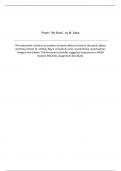Other
ENG1501. My Book, by M Xaba. Poem analysis and suggested responses for assignment 01 (2024).
- Institution
- University Of South Africa (Unisa)
This document provides an analysis of the poem My Book by M, Xaba, prescribed for ENG1501 in academic year 2024. The document provides advice on how to write a reflective essay. It also address these literary devices: punctuation, tone, imagery, sound device, theme; as well as suggest possible answ...
[Show more]



